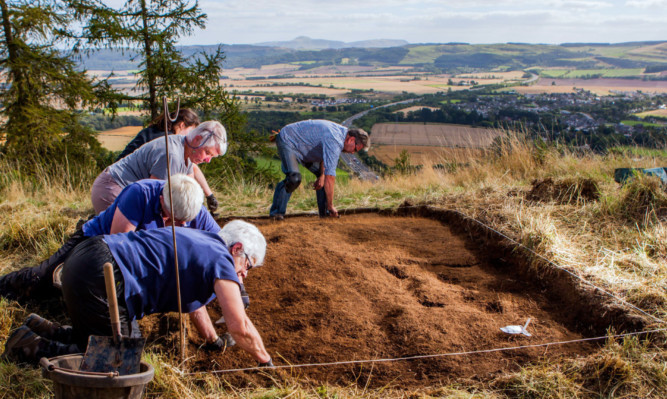Painstaking excavations of one of Tayside’s greatest iron age seats of power have been carried out on Moncreiffe Hill.
Chieftains once controlled the land for miles around from its summit, which was home to two giant hill forts.
Thick stone walls, perhaps as much as 12 feet high and topped by a log palisade, crowned the hill from where its ruler had a commanding view of his surroundings.
Despite its obvious importance, there has been almost no archaeological study of Moredun Top nor of the smaller fort on a lower site on the hill.
In fact, nothing but a small piece of jet has ever been removed from the site.
That is now changing as David Strachan from Perth and Kinross Heritage Trust leads a team on the hill to begin a detailed new project.
It is being delivered through the Tay Landscape Partnership with funding from the Heritage Lottery Fund, among others, and aims to uncover the secret past of the familiar landmarks, beginning with the smaller of the two forts.
Excavations at Moredun Top will then follow, with three separate digs to be carried out each year for the next three years.
This week the excavation team which includes professional support from AOC Archaeology will begin to unravel the site’s story, peeling back the layers to see what lies beneath the feet of the many visitors to the Woodland Trust site.
Also on the team will be a group of 15 volunteers, each with an interest in archaeology and the nation’s past, who will play an important part in the success of the project.
Moncreiffe hill fort, where the work is beginning, is believed to date back to the late iron age and has views over the Earn valley.
Hill forts feature regularly on the landscape of the Ochil and Sidlaw hills and a number have been excavated and studied.
Many of those studies were undertaken by Victorian archaeologists, who had no access to carbon dating, but it is thought that the sites are likely to have been used over a wide timeframe.
Though the occupants of each fort were probably power brokers in the area, none straddled the land like those who ruled from Moncreiffe Hill.
The stronghold would have been ideal for security and defence, offering commanding views of approach by land or water. Security would have been a key feature of the choice of location but the site would also have allowed for easy exploitation of the natural resources of the River Tay and the surrounding land, which, it is believed, would have been cultivated.
For more information, visit www.aocarchaeology.com/moncreiffe.
